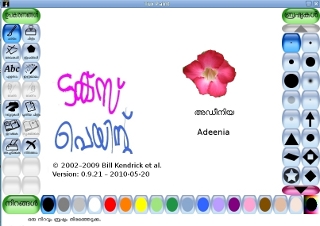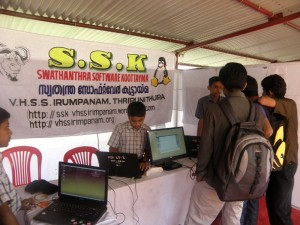Vocational Higher Secondary School Irimpanam
Location
The school is located in Irimpanam, an area close to the city of Tripunithura, in the Ernakulam district of the State of Kerala, India.
About
Founded in 1940, the Vocational Higher Secondary School Irimpanam is a privately owned school aided by the State. It offers instruction from Upper Primary to High School levels (grades 5 to 7 and 8 to 10 respectively). Nearly 1,000 students from 10 to 15 years old attend the school.
Motivation
Our institution took special interest in promoting the main aspects of the philosophy of the GNU Project, such as the freedom to share knowledge and the freedom to cooperate with our community by contributing improvements to computer programs. This awareness about Swathanthra Software (1) was largely the result of what we learned at the meetings organized by the Indian Libre User Group (ILUG-Cochin) in the nearby city of Kochi. Attending those meetings also helped us to work in close connection with the Free Software community.
How We Did It
The migration to Free Software in our school was the result of a project designed and established by the Government of Kerala, called IT@School. The project, started in 2001, involved several thousand schools in Kerala and in 2006 it switched completely to Free Software.
Training courses for teachers were implemented by the government to teach us the basics of the new Free Operating System and how to install it. The new system was customized for the first time by SPACE, an agency based in Kerala that promotes the use of Free Software in the private and public sectors. SPACE, as well as local Swathanthra Software users groups, played a fundamental role during the process by providing constant support to teachers. One of the workshops organized by SPACE helped us to build the website of our school using Free Software.
Training was not limited to software, it also included teaching the basics of hardware maintenance to teachers and students. In our school, 10 years old students know how to assemble a PC.
The use of Free programs in the classroom was facilitated by the implementation of training modules aimed at instructing teachers on the use of specific programs for teaching various subjects. For example, there was a training module for teachers of Mathematics on how to use Dr Geo for teaching geometry, another one for teachers of Chemistry on how to draw organic molecules using Chemtool, and many others.
Other training activities were conducted jointly by the school and ILUG-Cochin to teach us the use of different Free Software applications such as Blender, Inkscape, and the command line interface.
The school has also opened an IRC channel where students can ask questions about issues they may encounter.
Commitment to Free Software
At the beginning the new system was used on a dual-boot basis, because we teachers were not familiar with Free Software, but we soon got acquainted with it to a great extent. At present, no proprietary systems are installed in any of our computers and no proprietary programs are being used. Only Free Software is being used in the classroom and in the administration offices.
We use a wide range of free programs in the classroom, such as GIMP, Tux Paint, Audacity, GPeriodic and LibreOffice, but there are many others.
Students are also introduced to the programming language Python as from grade 8 (13 years old).
Results

Listen to a student pronounce the name of the Adeenia flower in Malayalam.
Education in the State of Kerala has become “IT-enabled,” meaning that students are getting first hand technology knowledge while learning regular curriculum subjects outside the IT Lab. This is possible due to the large number of high quality educational applications available in GNU/Linux.
The transparency and the cooperative method of Free Software helped students and teachers to dive deep into technology and made them capable of contributing to the community in various ways. One important contribution was the localization of the interface of Tux Paint in Malayalam, our mother tongue.
Another contribution was the addition of new stamps in TuxPaint. Native flowers were photographed and the pictures edited by 6th and 7th grade students using the image editing program GIMP. The resulting images were then integrated in TuxPaint with the name of the flowers written in Malayalam. As a plus, students recorded with their own voices the name of the flowers, so when the user selects one of the stamps, she will hear the name of the flower in Malayalam. A video was recorded to illustrate how it works and how the activity was done.
Watch and download the video. Read and download the English subtitles in SubRip format.
Both activities were promoted by Swathanthra Software Koottayma of VHSS Irimpanam (SSK VHSS Irimpanam), a Free Software group of teachers and students based on the school. Its aim is to build awareness on the philosophy of Free Software and to introduce new applications in GNU/Linux as a way of contributing to the community. The group organizes monthly meetings and it performs various kinds of activities to encourage its members to experiment and explore Free Software so as to put into practice the freedoms that it grants.
As a way of keeping in touch and sharing experiences with other schools and with the Free Software community, teachers and students each year participate in events such as the National Free Software Conference and the Cyber Safe Day.
The commitment and the collaboration of teachers, students and local groups was essential to the success of this large scale government project.
(1) Swathanthra is the Sanskrit word for “free” as in freedom.
Credits
Credits for both images shown on this page, as well as for the audio file, go to Swathanthra Software Koottayma of VHSS Irimpanam, who released them under a Creative Commons Attribution-Share Alike 3.0 Unported License.

The following report is based on information provided to us by the school's staff.